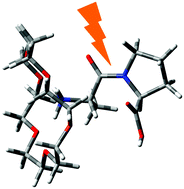Energy flow in peptides after UV photoexcitation of backbone linkages†
Abstract
We report on the dissociation channels after UV photoexcitation of peptide cations tagged with 18-crown-6 ether (CE). The model peptides chosen for study were singly protonated (Ala)n–Pro (n = 1, 2, 3) and Pro–Pro (Ala = alanine, Pro = proline) that all contain at least one tertiary amide group with high absorption cross section at 210 nm (5.90 eV). Statistical dissociation was identified from the loss of CE, a process occuring remotely from the initial site of excitation, and therefore requiring flow of energy to the ammonium group where the CE is bound. However, homolytic breakage of the peptide backbone at the site of excitation is competitive, resulting in so-called a radical cations. Density functional theory calculations of dissociation energies were done on the simplest system [Ala–Pro + H+](CE) and found to be 1.87 eV for CE loss and 3.29 eV for the formation of a+(CE) and x. These numbers were used to calculate statistical branching ratios for the dissociation processes based on detailed balance. After the absorption of two 210 nm photons (according to power-dependence measurements), the branching ratio between the two channels is calculated to be less than 10−4, far below the observed ratio of 0.65. Hence both statistical and non-statistical dissociation contribute to dissociation of these photoexcited peptides.

- This article is part of the themed collection: XUV/X-ray light and fast ions for ultrafast chemistry


 Please wait while we load your content...
Please wait while we load your content...